This code gets called before every redraw. I don't know how you're rotating/translating (timer or mouseDown), but in any case the methods described below can be done smoothly and appear natural to the user.
If your object is being clipped by the near plane, move the near cutoff plane back toward the camera (in this code, increase VIEWPLANEOFFSET). If the camera is too close to allow you to move the near plane far enough back, you may also need to move the camera back.
If your object is being clipped by the left, right, top or bottom clipping planes, adjust the camera aperture.
This is discussed in more detail below.
// ******************************* Distance of The Camera from the Origin
cameraRadius = sqrtf((camera.viewPos.x * camera.viewPos.x) + (camera.viewPos.y * camera.viewPos.y) + (camera.viewPos.z * camera.viewPos.z));
GLfloat phi = atanf(camera.viewPos.x/cameraRadius);
GLfloat theta = atanf(camera.viewPos.y/cameraRadius);
camera.viewUp.x = cosf(theta) * sinf(phi);
camera.viewUp.y = cosf(theta);
camera.viewUp.z = sinf(theta) * sinf(phi);
You'll see with the View matrix we're only defining the camera (eye) position and view direction. There's no clipping going on here yet, but the camera position will limit what we can see in that if it's too close to the object, we'll be limited in how we can set the near cutoff plane. I can't think of any reason not to set the camera back fairly far.
// ********************************************** Make the View Matrix
viewMatrix = GLKMatrix4MakeLookAt(camera.viewPos.x, camera.viewPos.y, camera.viewPos.z, camera.viewPos.x + camera.viewDir.x, camera.viewPos.y + camera.viewDir.y, camera.viewPos.z + camera.viewDir.z, camera.viewUp.x, camera.viewUp.y, camera.viewUp.z);
The Projection matrix is where the clipping frustum is defined. Again, if the camera is too close, we won't be able to set the near cutoff plane to avoid clipping the object if it's bigger than our camera distance from the origin. While I can't see any reason not to set the camera back fairly far, there are reasons (accuracy of depth culling) not to set the near/far clipping planes any further apart than you need.
In this code the camera aperture is used directly, but if you're using something like glFrustum to create the Projection matrix, it's a good idea to calculate the left and right clipping planes from the camera aperture. This way you can create a zoom effect by varying the camera aperture (maybe in a mouseDown method) so the user can zoom in or out as he likes. Increasing the aperture effectively zooms out. Decreasing the aperture effectively zooms in.
// ********************************************** Make Projection Matrix
GLfloat aspectRatio;
GLfloat cameraNear, cameraFar;
// The Camera Near and Far Cutoff Planes
cameraNear = cameraRadius - VIEWPLANEOFFSET;
if (cameraNear < 0.00001)
cameraNear = 0.00001;
cameraFar = cameraRadius + VIEWPLANEOFFSET;
if (cameraFar < 1.0)
cameraFar = 1.0;
// Get The Current Frame
NSRect viewRect = [self frame];
camera.viewWidth = viewRect.size.width;
camera.viewHeight = viewRect.size.height;
// Calculate the Ratio of The View Width / View Height
aspectRatio = viewRect.size.width / viewRect.size.height;
float fieldOfView = GLKMathDegreesToRadians(camera.aperture);
projectionMatrix = GLKMatrix4MakePerspective(fieldOfView, aspectRatio, cameraNear, cameraFar);
EDIT:
Here is some code illustrating how to calculate left and right clipping planes from the camera aperture:
GLfloat ratio, apertureHalfAngle, width;
GLfloat cameraLeft, cameraRight, cameraTop, cameraBottom, cameraNear, cameraFar;
GLfloat shapeSize = 3.0;
GLfloat cameraRadius;
// Distance of The Camera from the Origin
cameraRadius = sqrtf((camera.viewPos.x * camera.viewPos.x) + (camera.viewPos.y * camera.viewPos.y) + (camera.viewPos.z * camera.viewPos.z));
// The Camera Near and Far Cutoff Planes
cameraNear = cameraRadius - (shapeSize * 0.5);
if (cameraNear < 0.00001)
cameraNear = 0.00001;
cameraFar = cameraRadius + (shapeSize * 0.5);
if (cameraFar < 1.0)
cameraFar = 1.0;
// Calculte the camera Aperture Half Angle (radians) from the Camera Aperture (degrees)
apertureHalfAngle = (camera.aperture / 2) * PI / 180.0; // half aperture degrees to radians
// Calculate the Width from 0 of the Left and Right Camera Cutoffs
// We Use Camera Radius Rather Than Camera Near For Our Own Reasons
width = cameraRadius * tanf(apertureHalfAngle);
NSRect viewRect = [self bounds];
camera.viewWidth = viewRect.size.width;
camera.viewHeight = viewRect.size.height;
// Calculate the Ratio of The View Width / View Height
ratio = camera.viewWidth / camera.viewHeight;
// Calculate the Camera Left, Right, Top and Bottom
if (ratio >= 1.0)
{
cameraLeft = -ratio * width;
cameraRight = ratio * width;
cameraTop = width;
cameraBottom = -width;
} else {
cameraLeft = -width;
cameraRight = width;
cameraTop = width / ratio;
cameraBottom = -width / ratio;
}
